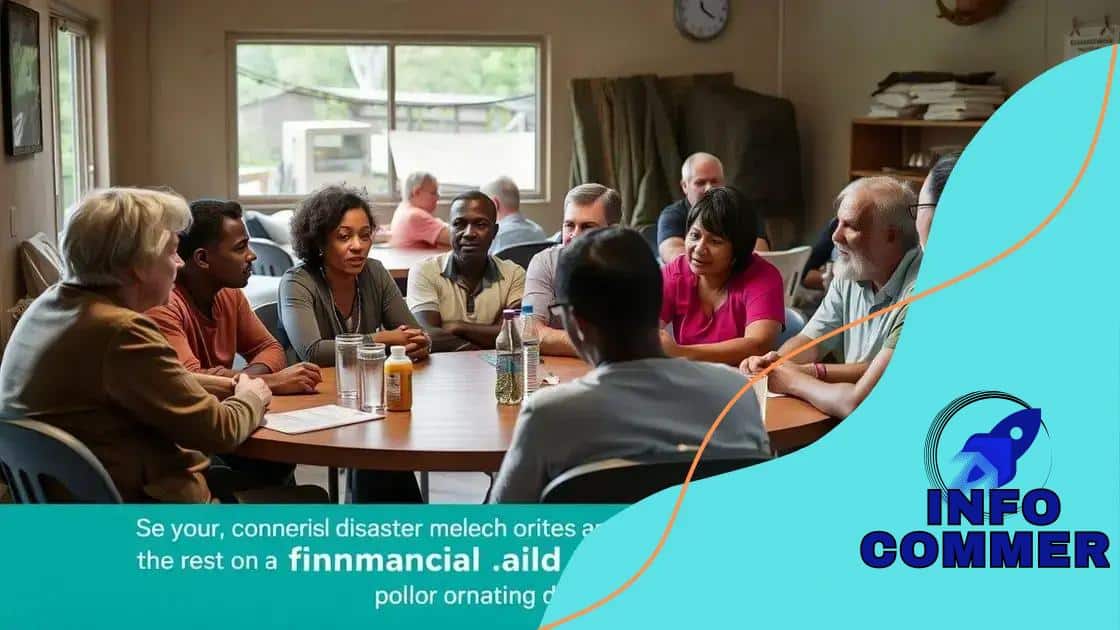Emergency financial aid programs for natural disaster victims

Emergency financial aid programs for natural disaster victims include government assistance, nonprofit support, and insurance benefits to help individuals recover and rebuild after a disaster.
Emergency financial aid programs for natural disaster victims offer vital support to those affected by unforeseen events. Have you ever wondered how these programs work and what resources are available to help rebuild lives?
Understanding emergency financial aid programs
Understanding how emergency financial aid programs function is crucial for those affected by natural disasters. These programs are designed to provide immediate relief when communities face urgent situations like floods, hurricanes, or wildfires. By knowing what is available, victims can access resources to help rebuild their lives.
What Are Emergency Financial Aid Programs?
Emergency financial aid programs offer timely assistance to individuals and families impacted by disasters. They often cover various needs, such as temporary housing, food, and medical expenses. The aim is to stabilize affected individuals during the recovery period.
Types of Assistance Offered
- Temporary shelter and housing support
- Food assistance and nutritional programs
- Medical expense coverage
- Cash assistance for immediate needs
Each program has its own set of criteria and offerings, making it essential for victims to research what is available in their area. Some programs may be specifically geared towards families, while others cater to individuals or businesses.
In addition to government programs, nonprofit organizations also provide valuable support. Many charities and local organizations work directly with disaster-stricken communities to offer financial aid. This can include assistance with bills, transportation, and job placement services.
Eligibility for Aid Programs
Eligibility for these programs varies, but often requires documentation of the disaster’s impact. Individuals will typically need to provide identification and proof of residence. Understanding the application process and required documents is important to ensure timely assistance.
The speed at which victims apply for these funds can make a significant difference. Working closely with local aid organizations can offer additional support and guidance during this difficult time.
In conclusion, being informed about emergency financial aid programs can create pathways to recovery for those affected by natural disasters. These resources are vital in helping individuals and families regain stability while they rebuild their lives.
Eligibility criteria for assistance
When applying for emergency financial aid programs, it’s essential to understand the eligibility criteria for assistance. These criteria can vary based on the program and the disaster’s impact. Knowing what is required can significantly expedite the application process.
Common Eligibility Requirements
Most programs ask applicants to meet specific conditions. These include:
- Proof of identity and residence
- Documentation showing the impact of the disaster
- Income verification for financial need
- Other relevant paperwork as specified by the program
It’s important to gather the necessary documents before starting the application. Each program may have different requirements, so checking with local agencies is wise.
The application process can feel overwhelming, making it essential to clarify any doubts you may have. Some organizations offer guidance and support to help applicants navigate the eligibility criteria effectively. Working closely with these groups can provide clarity and assist in gathering documentation.
Additional Factors
Some programs may consider factors like age, disability status, and family composition. For instance, households with children or elderly members might receive prioritized assistance. Understanding these factors can help applicants prepare better.
Staying informed about updates to financial aid programs is vital, especially since eligibility can change after a disaster. Regularly checking official resources and community announcements can ensure that you don’t miss vital information.
Application processes for aid programs

Understanding the application processes for aid programs is vital for those needing assistance after a natural disaster. Each program has specific steps and requirements that applicants must follow to receive help. Knowing these steps can streamline the process and reduce stress.
Steps to Apply for Aid
The application process typically involves several key steps. Applicants should start by gathering required information and documentation early. Common steps include:
- Researching available programs in your area
- Completing the application form accurately
- Submitting necessary documentation
- Following up with the agency for updates
Taking the time to understand what is required can significantly improve the chances of receiving aid. Each program may request different types of documentation, such as proof of income, identification, and specific details about the disaster’s impact.
After submitting the application, applicants should keep in touch with the agency handling their request. Many programs have dedicated representatives who can answer questions and offer assistance during this time. If there is a delay or an issue with the application, prompt communication can help resolve it quickly.
Using Online Resources
Many aid programs now offer online applications, which can be more convenient and faster. Applicants should be sure to visit official websites to obtain accurate information and avoid scams. Using reputable sources ensures that the application process is safe and legitimate.
In addition, victims can access local organizations for help with filling out applications. Volunteers often assist with identifying the right programs to apply for and guiding applicants through each step of the process. This can be especially helpful for those unfamiliar with online applications or those who may need extra support.
Types of financial aid available
Understanding the various types of financial aid available is essential for individuals affected by natural disasters. These resources can provide necessary support to help victims recover and rebuild their lives.
Government Assistance Programs
Many government programs are designed to offer financial aid during emergencies. These typically include:
- FEMA Assistance: This federal aid provides support for temporary housing, home repairs, and other disaster-related expenses.
- State Programs: Many states have their own financial aid programs that work alongside federal assistance to provide additional help.
- Small Business Administration Loans: For businesses affected by disasters, low-interest loans may be available to help them recover.
- Direct Cash Assistance: This type of aid allows families to cover immediate expenses like food and clothing.
These programs often have specific eligibility requirements. It’s important to check what documentation is needed to apply for assistance.
Nonprofit and Community Resources
In addition to government assistance, various nonprofit organizations provide financial support. Charities often focus on helping specific groups, such as families with children, the elderly, or disabled individuals. Some examples include:
- Red Cross: Offers emergency assistance, shelter, and financial aid to disaster victims.
- Salvation Army: Provides financial support for housing, food, and other essential services.
- Local Churches and Community Organizations: Many local groups mobilize to support their communities during emergencies, offering food, clothing, and financial help.
Nonprofit organizations can sometimes provide aid more quickly than government programs, making them a valuable resource during emergencies.
Insurance Coverage Options
Many people may not realize that insurance policies can also provide financial assistance after a disaster. Homeowners, renters, and business insurance may cover specific damages incurred during a natural disaster. This can include:
- Home Insurance: Covers damages to your property and personal belongings.
- Auto Insurance: Can provide coverage for car damage caused by disasters.
- Business Interruption Insurance: Offers financial support for lost income due to business closure from a disaster.
Understanding your insurance policies and the coverage available is critical for maximizing financial support following a disaster.
Resources for further support and information
Accessing the right resources for further support and information can help individuals affected by natural disasters find the assistance they need. Knowing where to look can make a significant difference in recovery efforts.
Government Resources
One of the first places to seek help is through government agencies. Federal and state resources often provide up-to-date information on available assistance programs. For example:
- FEMA: The Federal Emergency Management Agency offers support for recovery and rebuilding efforts after disasters.
- State Emergency Management Offices: State-level offices provide resources and information tailored to specific local needs.
- Local Government Websites: Many local government sites have dedicated sections for disaster assistance and recovery resources.
These agencies can be excellent starting points for anyone seeking aid and support.
Nonprofit Organizations
In addition to government resources, many nonprofit organizations can offer various forms of assistance. These organizations often provide valuable services such as food distribution, clothing, and financial help. Some key resources include:
- United Way: Offers community support and connects individuals with local resources.
- American Red Cross: Provides emergency relief and recovery services after disasters.
- Salvation Army: Offers food, shelter, and financial assistance to those in need.
Nonprofit organizations often collaborate with local agencies to better understand community needs and provide effective support.
Online Resources and Hotlines
Online platforms can provide a wealth of information about available resources. Victims can access websites and hotlines dedicated to helping those affected by disasters. Websites like DisasterAssistance.gov allow users to find assistance quickly. They can also connect with community resources through local hotlines.
Social media can be another useful avenue for staying informed about available aid. Many organizations use these platforms to share updates and resources.
Overall, gathering information from multiple sources can empower individuals to take charge of their recovery process. Knowing where to seek help ensures that no one has to navigate this challenging journey alone.
FAQ – Frequently Asked Questions about Emergency Financial Aid Programs for Natural Disaster Victims
What types of financial aid can I access after a disaster?
You can access government assistance, nonprofit support, and potential insurance payouts depending on your situation.
How do I apply for emergency financial aid?
You typically need to gather documentation, fill out an application, and submit it to the relevant agency or organization.
What are the eligibility criteria for receiving aid?
Eligibility often includes proof of identity, documentation of disaster impact, and specific requirements set by each program.
Where can I find reliable information about available resources?
You can find information on government websites, nonprofit organizations, and local community centers that provide support and resources.





